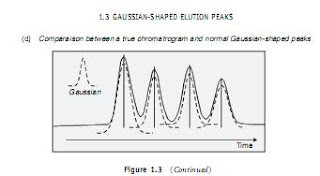
 The chromatogram is the representation of the variation, with time (rarely volume), of the amount of the analyte in the mobile phase exiting the chromatographic column. It is a curve that has a baseline which corresponds to the trace obtained in the absence of a compound being eluted. The separation is complete when the chromatogram shows as many chromatographic peaks as there are components in the mixture to be analysed (Figure 1.3).
The chromatogram is the representation of the variation, with time (rarely volume), of the amount of the analyte in the mobile phase exiting the chromatographic column. It is a curve that has a baseline which corresponds to the trace obtained in the absence of a compound being eluted. The separation is complete when the chromatogram shows as many chromatographic peaks as there are components in the mixture to be analysed (Figure 1.3).A constituent is characterized by its retention time tR, which represents the time elapsed from the sample introduction to the detection of the peak maximum on the chromatogram. In an ideal case, t is independent of the quantity injected. A constituent which is not retained will elute out of the column at time tR, called the hold-up time or dead time (formerly designated t). It is the time required for the mobile phase to pass through the column.0
The difference between the retention time and the hold-up time is designated by the adjusted retention time of the compound, tR
. If the signal sent by the sensor varies linearly with the concentration of a
compound, then the same variation will occur for the area under the corresponding peak on the chromatogram. This is a basic condition to perform quantitative analysis from a chromatogram.